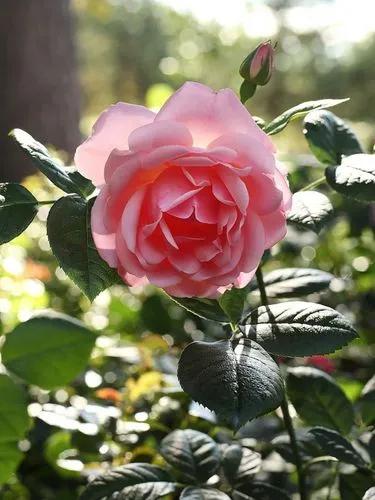Odontoglossum crispum has an ovoid pseudobulb, between 3 and 4 inches long, from the apex of which emerge two soft-textured, erect to arching, linear to strap shaped or lanceolate leaves. The leaves are sharply pointed at the tip and narrowed below where they are longitudinally folded along the mid-vein at the base to form a long, narrow, petiole-like stem. The gracefully arching flower spike, which can be up to 20 inches long, emerges from the base of a recently matured pseudobulb along the centre-line of the upper basal sheath. Flowers are closely spaced in a raceme on the upper part of the flower spike, but there are often two or three lateral branches at the base of the raceme. Each flower is carried on a pedicellate ovary that is up to 0.9 in long. There are between 6 and 24 flowers on each inflorescence. The blossoms are the most variable in the Odontoglossum genus in terms of size, colour and degree of crimpling along the segment margins. The flowers are mostly white or pale rose, sometimes more or less spotted and blotched with brownish or reddish brown. The callus at the base of the lip is yellow and is often marked with red lines. The widely spread, flat-opening flowers are 3 to 4 inches across with very wide sepals that are elliptic, have sharply pointed tips, often overlap and are variously crisped or wavy-margined or toothed and notched along the margins. The dorsal sepal is lanceolate to egg-shaped, undulate on the margin and 1.2 to 2.0 inches long by 0.5 to 0.9 inches wide. The obliquely spreading lateral sepals are similar in size to the dorsal sepal. The horizontally spreading petals are egg-shaped to elliptic or oblong elliptic, 1.2 to 1.8 inches long by 0.7 to 1.5 inches wide, and have margins that are wavy and fairly deeply notched or toothed. The lip is oblong or somewhat fiddle-shaped. It is 0.8 to 1.2 inches long by 0.5 to 0.6 inches wide, has toothed margins and is rather sharply pointed at the apex. The callus is fleshy with a pair of diverging lobes at the apex. The slender, slightly arching column is 0.6 to 0.7 inches long and has a pair of broad wings with fringed margins toward the apex.
Odontoglossum Orchid Care
Odontoglossum Crispum



How to Care for the Plant

Water

Orchids require a great deal of water. In fact, in periods of high temperatures they might need to be watered twice a day. During the growing season, the growing medium should be consistently moist but not soggy.

Fertilizer

From the spring to early fall, feed your fern with a liquid houseplant fertilizer at half strength once a month. No fertilization is necessary over the late fall and winter months.

Sunlight

It prefers temperatures above 65 degrees Fahrenheit. They can tolerate lower temperatures, but prolonged exposure to cold can have a profound effect on a plant's growth and flowering.

Soil

These orchids naturally grow in rocky areas with little soil. Their large roots meander through the air and grasp onto nearby trees and other objects. Growing them in a typical potting mix can kill the plants.

Temperature

It prefers temperatures above 65 degrees Fahrenheit. They can tolerate lower temperatures, but prolonged exposure to cold can have a profound effect on a plant's growth and flowering.

Popularity

35 people already have this plant 7 people have added this plant to their wishlists
Discover more plants with the list below
Popular articles






